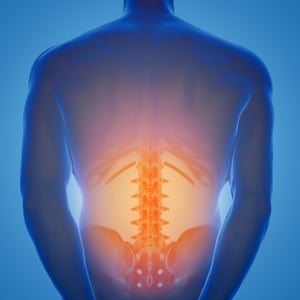 Last month we began our discussion of common junk science myths that seem to persist in the personal injury arena, no matter how much evidence has mounted to the contrary.
Last month we began our discussion of common junk science myths that seem to persist in the personal injury arena, no matter how much evidence has mounted to the contrary.
Continuing in that theme, this month we’ll tackle one of the most common tactics used in an attempt to avoid fair compensation for injuries sustained in motor vehicle collisions.
This strategy involves blaming any symptoms or pain on pre-existing degenerative changes that had nothing to do with the accident.
On the surface, this can appear to be a very compelling argument. After all, why should insurance carriers be responsible for compensating people for injuries that existed before the crash even occurred?
There are several major logical flaws with this strategy which we’ll address. As a non-lawyer I won’t discuss the legal strategy in detail, but there’s a few points that are worth noting nonetheless.
The first way to tackle this is to introduce the “brittle plaintiff” concept. This basically says that people with pre-existing conditions such as arthritis, disc de- generation, or previous auto accident injuries are much more susceptible to permanent injury with a traumatic event than individuals without these conditions.
I tell my patients that as long as their insurance policy insures them as they are (i.e. there was no exclusion for complications due to their diabetes, arthritis, disc bulges, etc) that they have the right to receive treatment for their injuries.
It certainly seems logical that a frail senior citizen with osteoporosis and arthritis in the spine will take longer to heal, and suffer more severe injuries in a crash.
I explain it to patients as a truckload of bricks hitting a wall vs. a truckload of eggs.
I’ll say, “Unfortunately Mrs. Jones, with your spine it was like the truckload of eggs. It’s going to be an up- hill battle, so just be patient as we go through the healing process.”
While this makes logical sense, what does the literature say?
Art Croft DC, PhD has done extensive research into complicating factors that predispose a patient to suffering from chronic pain with whiplash injury.
Among these are pre-existing degenerative changes, prior crashes, diabetes, and osteoporosis. Croft performed a meta-analysis of thou- sands of available studies to determine these factors.
Another interesting study by Tominga et al at Yale found that the ligaments in the neck were significantly weakened after a whiplash trauma.
The authors noted, “Significant decreases in ligament strength were observed following whiplash, supporting the ligament injury hypothesis of whiplash syndrome....this indicates whiplash loading causes decreased ligament strength.”
Pre-Existing Disc Pathology
 Let’s move on to the type of pre-existing injuries that is probably the most misunderstood and most frequently encounter: disc injuries.
Let’s move on to the type of pre-existing injuries that is probably the most misunderstood and most frequently encounter: disc injuries.
How many times have you had a client over the age of 40 with a disc herniation after a crash and the defense attorney or “expert” doctor replied that since it’s well known that most people beyond 40 have asymptomatic disc herniations, how can we know this was caused by the crash?
There are a few logical fallacies at work in this statement and I’ll help you understand how easy this is a refute. The first objection we must address is the “well known” studies that demonstrate asymptomatic disc herniations are common in the general population.
The misquoted study that is often referenced is from Boden published in 1990. The study found that 50% of adults over 40 exhibited “spinal abnormalities” on MRI without any pain.
Several things must be considered to understand this study. First is the fact that the 50% number does not represent herniations, but rather includes any arthritis, disc bulging, Spondylolisthesis, or other pathology.
This is an important consideration, because it is well understood that these types of chronic findings don’t correlate well with symptoms or pain.
This fact is further underscored by the AMA Guides 6th Edition which says in Chapter 17,
“Common conditions related to degenerative changes in the spine, including abnormalities identified on imaging studies such as annular tears, facet arthropathy, and disc degeneration, do not correlate well with symptoms, clinical findings, or causation analysis and not ratable according to the Guides.”
As the Guides clearly state, even if a patient has degenerative changes, these are very commonly present without pain.
If they are involved in a motor vehicle collision and suddenly experience an onset of symptoms, it is simply not reasonable to state that this problem was really there before the crash and they are somehow acting dis- honestly for financial gain.
Another problem with the Boden study is that it only examined the lumbar spine, which has no bearing on cervical disc pathology.
So if you ever hear a physician or Biomechanist state that 50% of adults over 40 have asymptomatic cervical disc herniations, you can point out what a gross misrepresentation of the literature this is.
To paint this in a more accurate light, studies have shown that the actual incidence of asymptomatic cervical disc herniations is between 2-8%, and around 15-20% in the lumbar spine.
Another way to think of this is that if your client has a disc herniation shown on MRI after a crash, and they did not complain of neck or arm pain prior to the crash, there’s about a 95% chance that the disc was not in fact pre-existing.
Even if the disc pathology did exist before the crash, if it was not causing pain it does not need to be apportioned out in an impairment rating.
When dealing with pre-existing conditions, the most important things to remember:
-
If the individual wasn’t in pain before the crash, it is more likely than not there was not a pre-existing disc herniation.
-
If there was any pre-existing arthritis, disc pathology, or other condition, the individual is more likely to suffer from chronic pain and permanent impairment.

.png?width=600&name=Ethos%20Health%20Group,%20(1).png)






